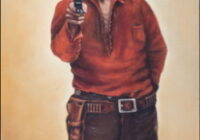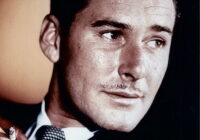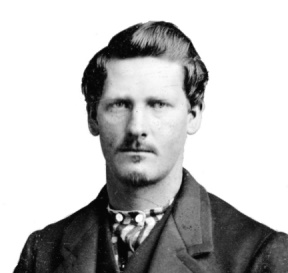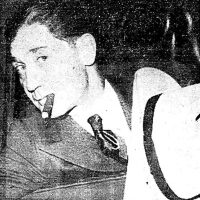|
Listen to this Gambling History blog post here
Getting your Trinity Audio player ready...
|
1950-1952
The Rhythm Boys were all about patterns of sound and movement but in relation to slot machines, not music.
Danny Foster, Johnny Pugh and Robert E. Black made $1,000 (about $11,800 today) from playing the slots for a few hours at the Club Cal Neva in Reno, Nevada in late 1950. Casino management asked them to leave. They did.
Sometime after, they were making money off of the El Cortez Hotel’s slots. During that spree, two Reno policemen approached and ordered them to leave the city by the next night or there’d be “blood on the streets,” Foster later reported to the press (Reno Evening Gazette, Oct. 31, 1951). In their threat, the officers referenced the trio’s continued, local slot playing. The Rhythm Boys moved on, to Lewiston, Idaho.
Trail of Winnings
Wherever the Rhythm Boys played slots, they won. They used a method for beating the machines that tipped the odds heavily in their favor, boosting slot payoffs by more than 10 percent, reportedly. Morrie Brodsky, manager at the Club Cal Neva, told news reporters he estimated that each of the Rhythm Boys had hit a jackpot once in every 15 plays in his casino.
More distressing to slot operators was that the rhythm method was legal. That fact made them “physically ill,” wrote The Lighter Touch columnist Frank Johnson (Nevada State Journal, May 4, 1958).
“Even today the mere mention of [Rhythm Boys] sends a chill through the gambling fraternity,” Johnson added. “It was that bad.”
Tricks of the Trade
The Rhythm Boys were nicknamed after their technique. It involved first determining a slot machine’s timing cycle, by the sound the device’s air governor made. Next was repeatedly pulling the slot handle according to a certain rhythm, letting a specific amount of time pass between yanks. Doing so interfered with the timing, slowing it down or speeding it up, such that the reels then “literally floated,” Johnson wrote.
He explained that proficient rhythm players could land the first and third reels in the position they wanted them in and hold them there. Then they could wait for the middle reel to spin to the needed position for a winning row and once there, stop it.
“It’s in the way they pull the handle of the slot. You get it going with a rhythm to it, the right rhythm. And it’ll jackpot for you every time,” columnist Stan Delaplane wrote, quoting a blackjack dealer at Reno’s Circle RB Lodge (Reno Evening Gazette, Feb. 27, 1960).
Attention Mounts
Once in Lewiston, two of the Rhythm Boys, Pugh and Foster, enticed the local news reporters to watch them play by betting they could land several $2 jackpots and spend less than $50 in doing so.
Successful, the duo collected $210 ($2,300 today) in 45 minutes’ time, having fed the machine only $20.
That afternoon, Foster and Pugh entered the 600 Club in Lewiston, and the proprietor turned his slot machines so their front faced the wall.
In October 1951, despite many slot operators urging them to stop playing slots in Lewiston, the Rhythm Boys announced they planned to stay in Idaho for years and make a career out of cleaning up on the gambling machines.
Even Classes on It
The rhythm method had been around since before the Boys drew widespread attention to it. Reportedly, it originated in Las Vegas, Nevada, even was taught there, then expanded.
Johnson explained in his May 4, 1958 column. “One of the first institutions of higher learning in Las Vegas was a special college for rhythm players conducted by the man who developed the system. It was no cheap diploma mill. The cost was $500 plus expenses for two weeks of concentrated instruction. Probably there were no more than 30 or 40 graduates during the time the school was in existence, but they were enough to endanger the whole slot machine industry.”
An affiliated school was located in Idaho.
Rhythm is Gonna Get You
The great publicity surrounding the three slots stars and their method, which the Rhythm Boys invited, was their undoing.
“The thing that really hurt was the fact the rhythm boys were so obvious,” Johnson wrote. “Other casino patrons seemed to catch on wherever they played. Pretty soon jackpots would begin falling all around the section where the rhythm expert was in.”
No longer able to play publicly, the trio sought to capitalize on their system by selling it, outlined in a booklet titled How We Beat The Slots, for $2 a pop. In the publication, they Rhythm Boys noted that “publicity barred us from playing in some clubs and made us unwelcome in others.”
To start, in early 1952, the rhythm method kings sent an estimated 30,000 letters to residents of Eastern Washington and Northern Idaho in which they offered their treatise for sale.
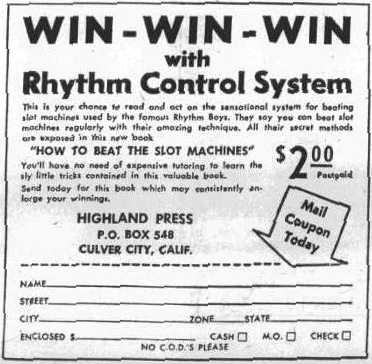
End of the Road
Eventually, savvy slot machine mechanics learned through the rhythm method course or the grapevine about this shortcoming of slot machines and sought to eradicate it. (Bud Garaventa, the foreman of Harrah’s Club’s slot machine repair shop, was one who attended the class, according to Johnson.)
The solution was a mechanism added to the inside of a slot machine. Described as windmill like, it spun when the slot handle was pulled and dictated how long each reel would spin. It prevented the floating of any and all reels but didn’t change the game’s odds.
“This [development] was at least six or seven years ago, and since then [the industry] has seen a rare slot machine not so equipped,” Johnson wrote in 1961 (Nevada State Journal, Dec. 27).

